page 3
As pointed out previously, many readers are already familiar with Marx's heavy usage of dichotomy in presenting his ideas of class struggle which was used to emphasize an orientation of comparing different social structures in different time periods as an established reoccurrence from which he wanted to assist in removing the many oppressed from the shackles of this repetition. And some of these same readers are aware of his lesser usage of trichotomy in which three social classes were pointed out. Such a methodology of analysis... however, did not incorporate enough information in order for readers to distinguish this "twoness" and "threeness" as recurring cognitive patterns that need to be taken into account because they relate to a proclivity in human thinking processes due to a necessary adaptation to environmental circumstances that affect our sociological thinking. Like Marx's awareness of recurring developmental patterns with respect to labor, industrialization coupled with Capital that becomes a poorly distributed resource... these are but affects of more basic patterns that we need to be fully aware of.
In other words, we can identify a 1,2,3 developmental trend in human cognition with the added feature that these three, because of an identifiable environmental influence, will result in more instances of an already existing 3 -to- 1 ratio. But the development is not set in stone because of our biological malleability which allows individual changes forward, backward, alternatively, depending on individual receptivity and overall environmental circumstances which can create individual scenarios of this patterning. Just like in biology, there are fluctuations in human thinking with respect to developmental expressions of the patterning.
Although it has already been shown elsewhere, let's review the presence of a 1,2,3 pattern occurring with the human brain and attributes already widely recognized, though in a superficial manner (without being related to a numerically identifiable pattern or to a larger sense of human sociology related to a biology whose developmental trend can be more definitively mapped devoid of the many subjective interpretations in use for describing progress, regression, and a lull period between the two).
Many people are already familiar with Paul D. MacLean's Triune Brain concept:
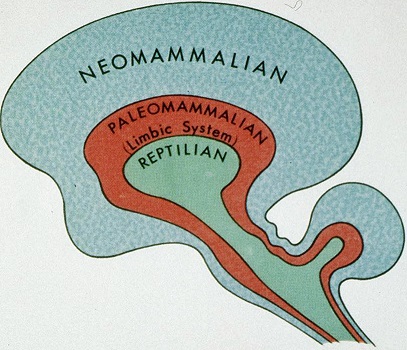 Brain Evolution— The Triune Brain Theory |
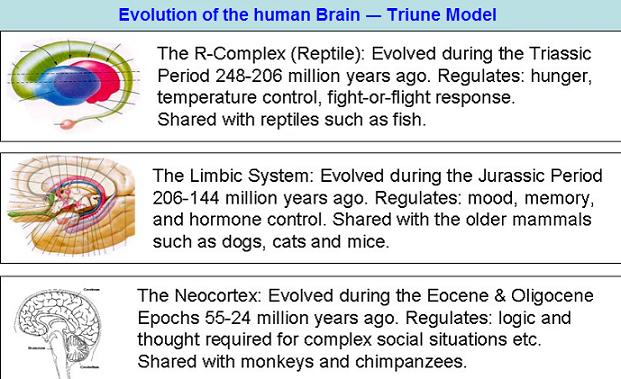 Threesological page 6 |
And many people are aware of the different attributes of the brain's two more noted right and left hemispheres, though they may not be familiar with research that has said the right hemisphere develops slightly ahead of the left, and in fact juts out slightly more than the left as well... meaning that the right hemisphere precedes the left... like that of a smaller number in a number sequence:
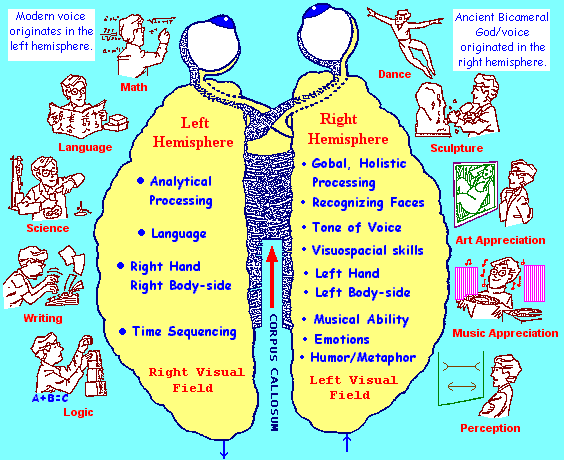
But what most people are not aware of, is that the attributes, when individually
itemized, yield distinctive "two" and "three" patterns which we can relate to
maturational cognitive development. And when an attribute of the left hemisphere
is used to take stock of a right hemisphered attribute, the "two" formula becomes
a "three", and vice versa. For example, there is a concept of musical triads
when the left brain analyzes music. And a three-patterned philosophical syllogism
can be rendered into a two-patterned dichotomy if the right brain exerts itself
over the left brain... both of which can be subsumed if the reptilian influence of
impulsiveness takes over. Certain people can be predisposed to using one of the
three brain structures over the other two. For example, criminal acts very often
occur because of poor impulse control. And those inclined to use a three-patterned
orientation may well resort to the adoption of citing three kinds of two-patterned
configurations such as in the:
Dichotomy, Dualism, Duality... An investigation into Marxist conceptualizations of
structure and agency by Alexander Gallas, though variations by other researchers
may include or substitute a reference with a "1" described as a monism, though the
overall discussion still retains a three-pattern structural formula.
| Left
Hemisphere (Predominantly 3-patterned) Math: Associative~ Commutative~ Distributive A2 + B2 = C2 ~ Sine- Cosine- Tangent 1st# (+ - X /) 2nd# = 3rd# Logic: Thesis ~ Antithesis ~ Synthesis Indulgence ~ "Middle Way" ~ Asceticism Major Premise ~ Minor Premise ~ Conclusion Time Sequencing: Seconds~ Minutes~ Hours Past ~ Present ~ Future Day~ Week~ Month Language - Speech - Grammar: Subject~ Object~ Verb Consonants ~ Vowels ~ Supra-segmentals Period ~ Question Mark ~ Exclamation point Right Body Side: Tri-cuspid heart valve Three-lobed lung |
Right
Hemisphere (Predominantly 2-patterned) Holistic: Macro versus Micro Whole versus Part Inner versus Outer Music: Major Scale vs Minor Scale Loud versus Soft (Quiet) Consonance vs Dissonance Visuospatial: (Art) Background vs Foreground Light vs Dark (Contrasts) 1 Dimension vs 2 Dimensions Emotions: Pain versus Pleasure Positive vs Negative Love versus Hate Left Body Side: Bi-cuspid heart valve Two-lobed lung |
|
(Reptilian) (Predominantly 1-Patterned) (Self)-Preservation~ (Self)-Procreation~ (Self)-Preeminence | |
| The right side of the body is affected by those having a stroke on the left "2" side of the brain. |  |
The left side of the body is affected by those having a stroke on the right "3" side of the brain. |
|
The correlations of two and three being made on this page are not typical considerations. However, I did come across a single reference concerning the tricuspid valve: http://www.madsci.org/posts/archives/mar97/855255174.An.r.html | ||
| The right side of the body is affected by those having a stroke on the left "3" side of the brain. | 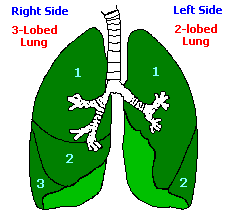 |
The left side of the body is affected by those having a stroke on the right "2" side of the brain. |
|
In recognizing that the left lung is smaller than the right lung (which provides room for the heart), let us conjecture that this is due to some past earlier developmental sequence just as we find the 1-layer, 2-layer, 3-layer sequential development of the 3 primordial germ layers (Ectoderm- Mesoderm- Endoderm) in primitive to more complex organisms. Hence, difference in size (dimorphism) as well as a two/ or three/ prominence may provide another link towards understanding developmental processes. Does this mean that the recurring smallness of the female to the male in many species indicates that females came before the male in terms of species-specific evolutionary development during particular environmental circumstances? | ||
Some additional two-patterned references found in music:
- Tension and Release
- Staccato and Legato
- Slow and Fast
- Ascending and Descending
Source: Threesological page 6
There are variations as to how the three-brain concept can be labeled. In the following image we see what might be described as a humanistic interpretation that is intended to portray a positive perspective without divulging what a more intense scrutiny can reveal. Alongside it is a different labeling system that dives a bit deeper into the substratum of generalized appearances. And even though Paul D. MacLean's "onion skin" model is different than the sequencing of the brain's development from Reptilian → Old Mammalian → New Mammalian characteristics, which is a means of describing the occurrence of maturational stages of development.
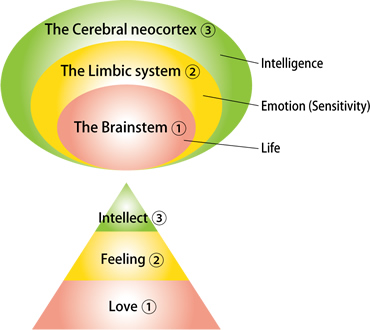 Heguru: Art of the ability development |
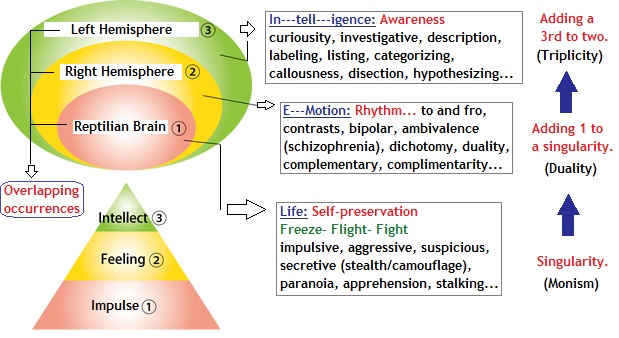 |
Using the left hemisphere attributes which involve analyzing material, we often find that this yields a "three" formula. If we look at information using the right hemisphere which quite often involves an indulgence with emotionality, there is an inclination to use a "two" formula. A Reptilian perspective of "self"-survival, generally involves a "one" orientation... that may be aligned with one-self, one's family, one's friends, one's co-workers, one's race, one's religion, one's business, one's sports team, one's music, one's career, one's property, one's community, one's city, state, nation, species, etc... The "one" is the operative identifier. Nonetheless, both aforementioned approaches to an analysis of the brain involve a three-patterned concept... even though further analysis may unveil more or less-patterned developmental characteristics. And this says nothing about those instances in which overlapping interpretations can yield larger quantities such as a "three" being replaced with a multiplicity such as "six"... etc. Nonetheless, both approaches are tools of examination being used for different applications.
With respect to using a "Reptilian → Old Mammalian → New Mammalian" maturational development model, it is of value to refer to a short article describing the dominance of the right hemisphere in infants, that is later subserved by a left hemisphere dominance as the brain of the infant matures:
The development of functional brain asymmetry during childhood is confirmed by changes in cerebral blood flow measured at rest using dynamic single photon emission computed tomography. Between 1 and 3 years of age, the blood flow shows a right hemispheric predominance, mainly due to the activity in the posterior associative area. Asymmetry shifts to the left after 3 years. The subsequent time course of changes appear to follow the emergence of functions localized initially on the right, but later on the left hemisphere (i.e. visuospatial and later language abilities). These findings support the hypothesis that, in man, the right hemisphere develops its functions earlier than the left. Source: The right brain hemisphere is dominant in human infants |
It is our assumption, given the incidence of developmental progression and that the "reptilian" denoted brain portrays the idea of an ancient brain formation; it is not too far a leap in imagination to consider that its dominance develops prior to the right hemisphere dominance, even if the "dominance" is short lived and occurs in the womb.
There is an environmentally influenced genetic predisposed pattern structure which imposes itself on psychological constructs of philosophically-based sociological concepts. But such a recurrence of patterning is not realized until a list of different ideas is presented which illustrates its presence as a basic mental formula, irrespective of how different symbols, words (or absences thereof)... or the applied definitions. All of them refer to a basic mental pattern being used as a survival mechanism... a mechanism that is like an adjustable wrench having to be altered as the environment deteriorates in an overall incremental fashion that may not be overtly perceived, and may involve occasional "punctuations" such as earthquakes, typhoons, solar flares, asteroid bombardment, tornadoes, droughts, sandstorms, disease, etc...
Even though the list has been used elsewhere, let's put it into the present context of discussion for those readers who have not encountered it elsewhere in their other reading sojourns:
| St. Augustine's Philosophy: | Memory ~ Understanding ~ Will |
| Comte's Philosophy: | Great Being ~ Great Medium ~ Great Fetish |
| Hegel's 3 Spirits: | Subjective Spirit ~ 0bjective Spirit ~ Absolute Spirit |
| Plotinu's Philosophy: | One ~ One Many ~ One and Many |
| Aristotle's 3 Unities: | Unity of Action ~ Unity of Time ~ Unity of Place |
| Sir F. Bacon's 3 Tables: | Presence ~ Absence ~ Degree |
| Thomas Hobbes's 3 Fields: | Physics ~ Moral Philosophy ~ Civil Philosophy |
| Immanuel Kant's 3 Critiques: | Pure Reason ~ Practical Reason ~ Judgment |
| Averroes's 3 Commentaries: | Little ~ Middle ~ Great |
| Karl Marx's 3 isms: | Communism ~ Socialism ~ Capitalism |
| Woodrow Wilson's 3 isms: | Colonialism ~ Racism ~ Anti-Communism |
| Hippocrates's Mind Disorders: | Mania ~ Melancholia ~ Phrenitis |
| Emile Durkeim's 3 Suicides: | Egoistic ~ Altruistic ~ Anomic |
| D. Liesman's 3 Social Characters: | Tradition-directed ~ Inner-directed ~ Other-directed |
| Erich Fromm's 3 Symbols: | The Conventional ~ The Accidental ~ The Universal |
| Pythagoras's "fusion" idea: | Monarchy ~ Oligarchy ~ Democracy (into harmonic whole) |
| M.L. King Jr.'s "Middle Road": | Acquiescence ~ Nonviolence ~ Violence |
| Kierkegaard's 3 Stages: | Aesthetic ~ Ethical ~ Religious |
| Husserl's 3 Reductions: | Phenomenological ~ Eidetic ~ Religious |
| St. Augustine's 3 Laws: | Divine Law ~ Natural Law ~ Temporal, or positive Law |
| Witness Stand "Laws": | Tell the Truth ~ The whole Truth ~ Nothing but the Truth |
| Titus Carus's 3 Ages: | Stone Age ~ Bronze Age ~ Iron Age |
| Feuerbach's 3 Thoughts: | God, 1st Thought ~ Reason, 2nd ~ Man, 3rd |
| Magnus's 3 Universals: | Ante Rem ~ In Rem ~ Post Rem |
| Max Weber's 3 Authorities: | Traditional ~ Charismatic ~ Legal-rational |
| F. de Sausure's 3 "Signs": | Sign ~ Signified ~ Signifier |
| Charles Pierces 3 "Signs": | Qualisign ~ Sinsign (token) ~ Legisign |
| John Keynes's 3 Eras: | Scarcity ~ Abundance ~ Stabilization |
| George Mead's 3 Distinctions: | Self ~ I ~ Me |
| Thrasher's 3-group Gangs: | Inner Circle ~ Rank & File ~ Fringers |
| Abe Lincoln's 3-For-All: | Of the People ~ By the People ~ For the People |
| Jesus Christ's 3 Praises: | In the name of the Father ~ Son ~ Holy Spirit |
| Samuel Clemmons' 3 lies: (Mark Twain) |
Lies ~ Damned Lies ~ Statistics |
| Sociology's 3 traditional Social Classes: | Lower- Middle- Upper |
| Georges Dumezil's Indo-European Socio-religious categories: | Priestly/Regal class Nobility/Warrior class Artisan/Craftsman/Agriculturist worker Class |
Table initially originated from: 3s Poster column 5 (1996-1997)
|
Thesis ~ Antithesis ~ Synthesis Indulgence ~ "Middle Way" ~ Asceticism Major Premise ~ Minor Premise ~ Conclusion Contradiction ~ Excluded Middle ~ Identity Principal | ||
| "God-ology": Omnipresent Omnipotent Omniscient |
"Metaphysics-ology": What is real How change comes What is mind |
Marxian "Dialectology": Unity of opposites Quantity & quality Negation of negation |
| Epistemology: How we know What is truth What is mind |
Axiology: Nature of good Nature of beautiful Nature of religious |
Ontology: Quality (1st-ness) Relation (2nd-ness) Representation (3rd-ness) |
3 times the fool: You can fool some people some of the time - Some people all the time - But not all people all the time.
3 traditional syllogism forms: Categorical - Hypothetical - Disjunctive
3-patterned basic adult syllogism: All ravens are black - Jack is a raven - Therefore, Jack is black.
3-patterned basic child syllogism: Fuzzy Wuzzy was a bear - Fuzzy Wuzzy had no hair - Fuzzy Wuzzy wasn't fuzzy was he?
Source for the present inclusion: Karl Marx's Brain Development
Karl Marx's usage of asserting his ideas for developing a better form of social self-governance by way of illustrating a recurring historical theme related to a human struggle involving different classes of workers over different eras, and then to use the information to describe what he believed would be the ultimate path along which humanity would travel to reach a destination called Communism, is particularly humorous. But Marx, Engles and the rest of those attempting to use such a formula can be forgiven either because particular types of information were not yet available, or they did not peer too far outside the context of traditional sociological ideas and attempt to utilize a more holistic approach towards comprehending forces which affect human behavior, and thus human society. In other words, it's rather naive to discuss changes in human society by considering the patterns of functionality amongst humans in their local, regional, national and global interactions, but fail to include patterns external to humans such as the environment of weather conditions, environment of diseases, environment of planetary and galactic changes, as well as underlying patterns in biological functionality on internalized structures... all of which can be correlated by identifying existing patterns which are adaptable... and thus subject to change. Marx's "Scientific Socialism" was not scientific enough.
Yet, relying on standard scientific models does not present us with a tool that will enable us to develop a "better" formula of governance. While the tool may well be innovative, this does not automatically mean it will be used. There are far too many traditionalists who want to keep things as they are. They are afraid to venture into unfamiliar territory. Like Einstein when he brought out his ideas in 1905, if it hadn't been for Max Planck:
|
...At first Einstein's 1905 papers were ignored by the physics community. This began to change after he received the attention of just one physicist, perhaps the most influential physicist of his generation, Max Planck, the founder of the quantum theory... "Einstein, Albert." Encyclopædia Britannica Ultimate Reference Suite, 2013. |
Studying Sociology, particularly in the sense of looking at the subject from a perspective that is non-traditional and involves a different type of analytical tool involving information from diverse sources, quite often reveals how backward the topical study of Sociology actually is... since most who study Sociology diverge into areas such as economics, psychology, ecology and culture, as is described in a Britannica article giving an overview of Sociology's historical development:
Founding the discipline Some of the earliest Sociologists developed an approach based on Darwinian evolutionary theory. In their attempts to establish a scientifically based academic discipline, a line of creative thinkers, including Herbert Spencer, Benjamin Kidd, Lewis H. Morgan, E.B. Tylor, and L.T. Hobhouse, developed analogies between human society and the biological organism. They introduced into sociological theory such biological concepts as variance, natural selection, and inheritance—asserting that these evolutionary factors resulted in the progress of societies from stages of savagery and barbarism to civilization by virtue of the survival of the fittest. Some writers believed that these stages of society could be seen in the developmental stages of each individual. Strange customs were explained by assuming that they were throwbacks to useful practices of an earlier period, such as the make-believe struggle sometimes enacted between the bridegroom and the bride's relatives reflecting the earlier custom of bride capture. In its popular period of the late 19th and early 20th centuries, social Darwinism, along with the doctrines of Adam Smith and Thomas Malthus, touted unrestricted competition and laissez-faire so that the “fittest” would survive and civilization would continue to advance. Although the popularity of social Darwinism waned in the 20th century, the ideas on competition and analogies from biological ecology were appropriated by the Chicago School of sociology (a University of Chicago program focusing on urban studies, founded by Albion Small in 1892) to form the theory of human ecology that endures as a viable study approach. Replacing Darwinist determinism Since the initial interest in evolutionary theory, Sociologists have considered four deterministic theories to replace social Darwinism. This search for new approaches began prior to World War I as emphasis shifted from economic theory to geographic, psychological, and cultural theory—roughly in that order. The Four Determinist Theories:
Early Schools of thought Scholars who established sociology as a legitimate social science were careful to distinguish it from biology and psychology, fields that had also begun to generalize about human behaviour. They did this by developing specific methods for the study of society. French Sociologist Émile Durkheim (1858–1917), prominent in this regard, argued that various kinds of interactions between individuals bring about certain new properties (sui generis) not found in separate individuals. Durkheim insisted that these “social facts,” as he called them—collective sentiments, customs, institutions, nations—should be studied and explained on a distinctly societal level (rather than on an individual level). To Durkheim the interrelations between the parts of society contributed to social unity—an integrated system with life characteristics of its own, exterior to individuals yet driving their behaviour. By positing a causal direction of social influence (from group to individual rather than the reverse, the model accepted by most biologists and psychologists of the time), Durkheim gave a much-needed framework to the new science of sociology. Some writers called this view “functionalism,” although the term later acquired broader meanings. Durkheim pointed out that groups can be held together on two contrasting bases: mechanical solidarity, a sentimental attraction of social units or groups that perform the same or similar functions, such as preindustrial self-sufficient farmers; or organic solidarity, an interdependence based on differentiated functions and specialization as seen in a factory, the military, government, or other complex organizations. Other theorists of Durkheim's period, notably Henry Maine and Ferdinand Tönnies, made similar distinctions—status and contract (Maine) and Gemeinschaft und Gesellschaft (Tönnies)—and predicted that civilization would progress along the lines of specialization, contractual relations, and Gesellschaft. Later anthropologists, especially Bronislaw Malinowski and A.R. Radcliffe-Brown, developed a doctrine of functionalism that emphasized the interrelatedness of all parts of society. They theorized that a change in any single element would produce a general disturbance in the whole society. This doctrine eventually gained such a following among social anthropologists that some advocated a policy of complete noninterference, even with objectionable practices in preliterate societies (such as cannibalism or head-hunting), for fear that eliminating the practice might produce far-reaching social disorganization.... |
Such a reference highlights the fact that while thoughts about Sociology may well go far back into time, the subject and its accompanying "Sociology" is not that old. It is very much in its infancy, despite all the intellectual ego-posturing of its many adherents. While some researchers do attempt a comprehensive approach in order to provide a more complete equation, different researchers with this same mindset are not developing an equation to fit all their ideas in. Each of them clings to their ideas as if they were some Universal law of Sociology, if only other would see their way in applying such ideas to their own theories. Yet few look upon all the theories as mere variables in a larger equation yet to be devised.
While there are some who fully appreciate this situation, and at first appearance give the impression of being open-minded, they can be amongst the first to raise an objection towards dismissing any proposed alternative idea, or even claim that another's idea is but a variable that is already present in their own view, except in different terminology. The only chance for a new idea to take hold is if older ideas become forgotten or a younger generation accepts the newer ideas more readily because it is presented in a language they more closely identify with. Much like Dante's Inferno(divided into three major sections— Inferno, Purgatorio, and Paradiso, which was written in the language of the common people (Tuscan dialect) instead of the (latin) language of the prevailing Aristocratic and scholarly class of his time, in which most materials were written in.
All in all, Sociology is now used as a means of analyzing social conditions though not necessarily with an interest in altering social conditions to improve them. Many social thinkers are mere observers, making references like someone taking a picture. The same goes for many Political Scientists as well as those involved with discussing Sociology from a particular perspective such as Marx's ideas. However, during its inception, those who had begun to establish the academic discipline of Sociology were inclined towards the idea that society might well be improved by a systematic analysis. When this assumption did pan out, and because an institution had been established, a different philosophical perspective had to be adopted in order to salvage Sociology as a worthwhile endeavor with which a genre of like-minded individuals could pursue a tradition of considerations with which honors and accolades could be awarded, defended, and taught to those who had a sincere interest in studying society, though they did not necessarily have any real "answers" with which to solve existing or future social problems.
For those of us who do want to apply attempts at correcting troubling social issues, knowing all too well that issues can overlap and be symptoms of other concerns that may or may not be fully recognized... we also realize that former and contemporary ideas... of those we are aware of, do not provide us with the necessary means for advancing a social effort that most, if not all of us can work to achieve a singular goal. While some think the only real way of accomplishing such a goal of social improvement is through a process of Revolution, and that the character of this Revolution entails some formula of anarchy; many of us are not yet ready to commit ourselves to such assertiveness, knowing all too well that once we have done so, we will bring the full force of our wealth and additional resources to bear on bringing the Revolution about.
Such a commitment is not about the silliness of burning flags, providing a forum for multiple issues to be separately addressed so as to present a Quixotic direction of fighting some windmill proliferated establishment or indulging in the hypocrisies so many protest groups characteristically come to formulate. In order for a Revolution to fully succeed, we must have a coherent philosophy which will enable us to run a Nation and not having to resort to oppressive methods to control a populace who are calling for the implementation of answers and not some jargonized idealism. Whereas idealism is appreciated as an incentive instructive proposal, it must be tempered within the guideline limitations of practicality... not as an oppressive constraint to be used by those wanting to exercise ulterior motivations for personal gain, but as the outline of presently achievable goals from which we may use as a stepping off point of departure with trial and error efforts to exceed our abilities.
For example, those who are in the U.S. know all too well that the usage of an Wikipedia: "Electoral College" formula of voting for a President is a means by which the vote of the people can be undermined. As the article points out, the people elect a President by an indirect method... In other words, the people do not practice an Actual Democracy, though the government, through its influence on public education, promotes the illusion that the people are governed by a democratic process. This is an issue which can be directly protested against and accompanied by progressively increasing (maturational) requests to change the system. It is an issue which can be easily understood, directly outlined, and allow the public to be provided with a direct observation of the steps taken, the reason for the steps, and how the government responds positively (in agreement) or negatively (dismisses, denies, makes excuses, etc...) in one's efforts. Such actions are necessary in establishing a precedent which makes the usage of Revolution a viable method for advancing the desires of the public. The public must be informed, and kept informed of what steps are taken, will be taken, and the reasons for taking them... on their behalf.
Communist and Socialists must get together and develop a dialogue that is progressively oriented for the group... which will include those wanting to advance actual democratic ideas and not merely maintain the phony practices of the current status quo. Remaining fractionated does little good, because it is a self-imposed form of divide and conquer, without the government having to lift a finger. A National and global formula of negotiation must take place amongst the different protest factions. Whereas many of us acknowledge that prevailing systems of government will be adamant against change, requiring that we resort to more aggressive tactics, this does not in any way absolve us from preparing the public for the confrontation. We are not engaged in protests with the intent of disrupting lives, but in improving the government. Disruption of lives frequently occurs because those who refuse to adopt changes on behalf of the people, have access to and control of resources which they use as a hostage, bribe, or poison. Social governing reformers must adopt a different strategy because the reusage of old ideas have been too diluted to provide any real potency of expansive effect.
Page Initially Created: Wednesday, 10-Aug-2016... 06:23 AM
Page First posted: Thursday, 11-Aug-2016... 08:09 AM
Updated Page: Sunday, 18-June-2017... 6:30 AM